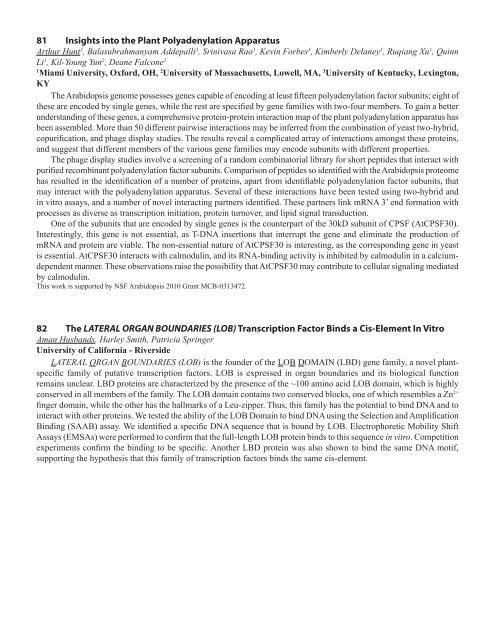75 Integrating Membrane Transport with Male Gametophyte ... - TAIR
75 Integrating Membrane Transport with Male Gametophyte ... - TAIR
75 Integrating Membrane Transport with Male Gametophyte ... - TAIR
You also want an ePaper? Increase the reach of your titles
YUMPU automatically turns print PDFs into web optimized ePapers that Google loves.
81 Insights into the Plant Polyadenylation Apparatus<br />
Arthur Hunt 3 , Balasubrahmanyam Addepalli 3 , Srinivasa Rao 3 , Kevin Forbes 3 , Kimberly Delaney 3 , Ruqiang Xu 1 , Quinn<br />
Li 1 , Kil-Young Yun 2 , Deane Falcone 2<br />
1<br />
Miami University, Oxford, OH, 2 University of Massachusetts, Lowell, MA, 3 University of Kentucky, Lexington,<br />
KY<br />
The Arabidopsis genome possesses genes capable of encoding at least fifteen polyadenylation factor subunits; eight of<br />
these are encoded by single genes, while the rest are specified by gene families <strong>with</strong> two-four members. To gain a better<br />
understanding of these genes, a comprehensive protein-protein interaction map of the plant polyadenylation apparatus has<br />
been assembled. More than 50 different pairwise interactions may be inferred from the combination of yeast two-hybrid,<br />
copurification, and phage display studies. The results reveal a complicated array of interactions amongst these proteins,<br />
and suggest that different members of the various gene families may encode subunits <strong>with</strong> different properties.<br />
The phage display studies involve a screening of a random combinatorial library for short peptides that interact <strong>with</strong><br />
purified recombinant polyadenylation factor subunits. Comparison of peptides so identified <strong>with</strong> the Arabidopsis proteome<br />
has resulted in the identification of a number of proteins, apart from identifiable polyadenylation factor subunits, that<br />
may interact <strong>with</strong> the polyadenylation apparatus. Several of these interactions have been tested using two-hybrid and<br />
in vitro assays, and a number of novel interacting partners identified. These partners link mRNA 3’ end formation <strong>with</strong><br />
processes as diverse as transcription initiation, protein turnover, and lipid signal transduction.<br />
One of the subunits that are encoded by single genes is the counterpart of the 30kD subunit of CPSF (AtCPSF30).<br />
Interestingly, this gene is not essential, as T-DNA insertions that interrupt the gene and eliminate the production of<br />
mRNA and protein are viable. The non-essential nature of AtCPSF30 is interesting, as the corresponding gene in yeast<br />
is essential. AtCPSF30 interacts <strong>with</strong> calmodulin, and its RNA-binding activity is inhibited by calmodulin in a calciumdependent<br />
manner. These observations raise the possibility that AtCPSF30 may contribute to cellular signaling mediated<br />
by calmodulin.<br />
This work is supported by NSF Arabidopsis 2010 Grant MCB-0313472.<br />
82 The LATERAL ORGAN BOUNDARIES (LOB) Transcription Factor Binds a Cis-Element In Vitro<br />
Aman Husbands, Harley Smith, Patricia Springer<br />
University of California - Riverside<br />
LATERAL ORGAN BOUNDARIES (LOB) is the founder of the LOB DOMAIN (LBD) gene family, a novel plantspecific<br />
family of putative transcription factors. LOB is expressed in organ boundaries and its biological function<br />
remains unclear. LBD proteins are characterized by the presence of the ~100 amino acid LOB domain, which is highly<br />
conserved in all members of the family. The LOB domain contains two conserved blocks, one of which resembles a Zn 2+<br />
finger domain, while the other has the hallmarks of a Leu-zipper. Thus, this family has the potential to bind DNA and to<br />
interact <strong>with</strong> other proteins. We tested the ability of the LOB Domain to bind DNA using the Selection and Amplification<br />
Binding (SAAB) assay. We identified a specific DNA sequence that is bound by LOB. Electrophoretic Mobility Shift<br />
Assays (EMSAs) were performed to confirm that the full-length LOB protein binds to this sequence in vitro. Competition<br />
experiments confirm the binding to be specific. Another LBD protein was also shown to bind the same DNA motif,<br />
supporting the hypothesis that this family of transcription factors binds the same cis-element.





